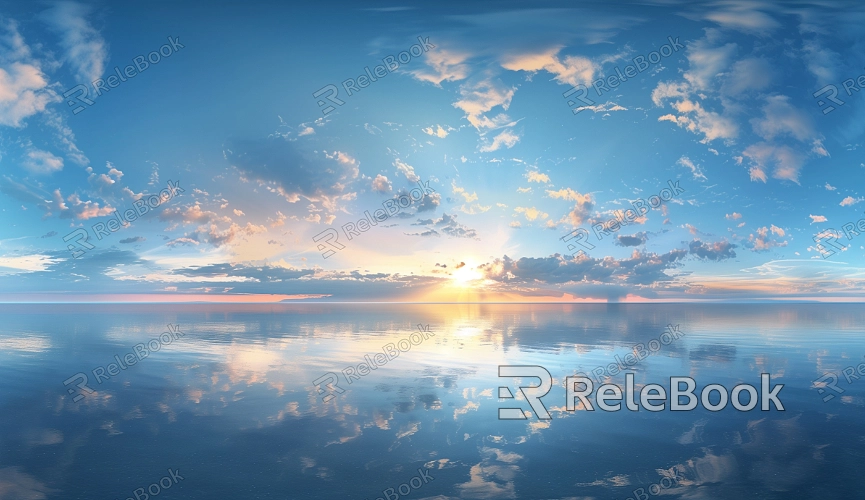How to Adjust Brightness and Contrast in HDR Skybox Textures?
In game development, architectural visualization, and virtual reality, skybox textures are commonly used to create realistic lighting environments. However, designers often encounter issues with the brightness or contrast of HDR skyboxes. Overly bright scenes can appear distorted, while images with insufficient contrast may lack depth. Mastering the techniques to adjust the brightness and contrast of HDR skyboxes is crucial for optimizing rendering effects. In this article, we'll explore several methods for adjusting the brightness and contrast of HDR skyboxes, applicable to workflows in Blender, Unity, Unreal Engine, and other popular 3D software.

1. Understanding the Role of HDR Skyboxes
HDR skyboxes not only serve as background images but also influence the overall lighting and tone of a scene. High Dynamic Range (HDR) images store detailed information in both bright and dark areas, helping designers create more realistic ambient lighting effects.
Why adjust brightness and contrast?
Brightness: Excessive brightness can cause a scene to look distorted or overexposed, while low brightness might lead to a lack of visual appeal.
Contrast: Insufficient contrast can make shadows and highlights appear washed out, reducing the overall clarity of details.
Common adjustment needs include enhancing light and shadow details, reducing overexposure, or boosting the scene’s visual appeal.
2. Using Material Settings in 3D Software
In most 3D modeling software, HDR skybox textures are loaded through material settings, making it easier to adjust brightness and contrast. Mainstream software like Blender, Unity, and Unreal Engine provides parameter controls for skybox textures in the material editor.
Brightness Adjustment:
Look for parameters such as “Exposure” or “Brightness” in the material panel. Adjusting these values will change the overall brightness of the skybox. Increasing the exposure will brighten the scene, while lowering it will darken the environment.
This method significantly affects the global lighting in the scene, allowing you to fine-tune the light intensity.
Contrast Adjustment:
In software like Unity and Unreal, you can address contrast issues through color adjustment options in the material editor. Increasing contrast will make the transitions between light and dark areas more pronounced, bringing out finer details.
3. Post-Processing for Brightness and Contrast Control
Some 3D software offers post-processing effects, allowing you to adjust the overall brightness and contrast of the entire scene, not just the skybox.
Global Brightness Adjustment:
Using tools such as "Exposure Control" or "Tone Mapping" within the post-processing module, you can fine-tune the scene's global brightness, ensuring that the HDR skybox’s lighting is consistent with the rest of the environment.
Enhancing Contrast:
With post-processing’s "Color Grading" tool, designers can manipulate the scene's contrast by adjusting curves for highlights, shadows, or midtones. This not only improves contrast but also preserves important details.
This approach is more flexible and is especially useful when dealing with multiple light sources, as post-processing can unify the visual effects.

4. Editing HDR Textures Directly in Image Software
For more precise control, designers can edit HDR textures directly using image editing software like Photoshop or GIMP. Adjusting brightness and contrast before importing the texture into 3D software ensures finer control over the results.
Editing HDR Files in Photoshop:
Open the HDR file and navigate to “Image > Adjustments > Brightness/Contrast.” You can then fine-tune the brightness and contrast until you achieve the desired effect.
Once the adjustments are complete, save the file in HDR or EXR format to retain the high dynamic range data, ensuring proper display in 3D software.
This method is ideal for custom skybox textures, allowing you to make adjustments beforehand to achieve the intended outcome when imported.
5. Balancing Skyboxes with Other Light Sources
Even after successfully adjusting the brightness and contrast of the HDR skybox, overlooking other light sources in the scene can result in unbalanced visuals. Thus, it's crucial to maintain harmony between the skybox and scene lighting.
Combining with Additional Light Sources:
The scene may contain other light sources like directional lights or point lights. Ensure these sources complement the lighting from the HDR skybox. If the additional lights are too strong or weak, they can disrupt the overall lighting effect.
Matching Ambient Lighting:
Align the intensity of the ambient light with the skybox brightness, so shadows and highlights transition smoothly, avoiding jarring bright or dark areas.
6. Optimizing Performance While Maintaining Visual Quality
Adjusting HDR skybox textures can affect not only the visual outcome but also performance, especially in real-time rendering environments. Therefore, performance optimization is essential when altering brightness and contrast.
Lowering Texture Resolution:
High-resolution HDR textures can consume a significant amount of memory and processing power. If the quality requirements are not too high, consider reducing the texture resolution to enhance rendering performance.
Using Compressed Formats:
In Unity or Unreal, you can utilize compressed texture formats (like BC6H or ASTC) to reduce the file size of HDR textures. This helps improve performance without noticeably sacrificing visual quality.
7. Testing and Iterating
Each scene has its unique lighting and design requirements, so testing and iterating adjustments to the brightness and contrast of HDR skybox textures is necessary.
Testing in Different Lighting Conditions:
Test the HDR skybox under various lighting conditions, such as day, night, or indoor settings. The performance of brightness and contrast may vary drastically depending on the lighting.
Gathering Feedback and Refining:
Share the initial results with team members or clients, gather feedback, and further fine-tune the HDR skybox’s brightness and contrast if needed.
By adjusting the brightness and contrast of HDR skybox textures, you can significantly enhance the visual quality of 3D scenes, boosting the overall lighting effects. Through material settings, post-processing, and image editing, designers have flexible options to meet the specific needs of different environments, ultimately achieving the desired visual impact.
If you're looking for high-quality HDR image resources, 3D textures, SketchUp models, or 3ds Max models to bring your virtual environments to life, Relebook offers a wide range of options to help you achieve exceptional visual results in your projects.

